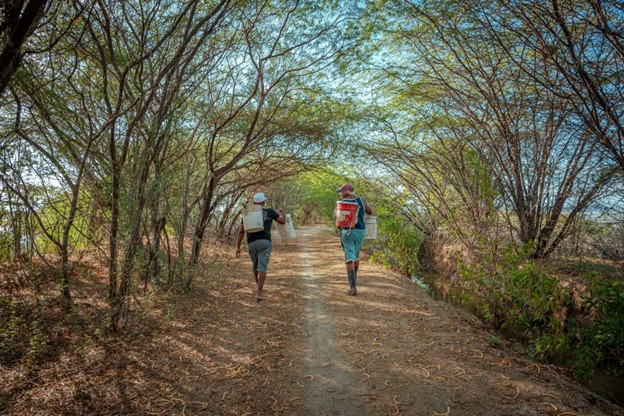
How can social intermediaries use entrepreneurship as a tool to bring together fragmented communities? In the Spring of 2019, our co-author team embarked on a journey to explore this question in the context of rural Colombia, where decades of conflict, narcotrafficking, and poverty have left many communities disconnected despite their geographic proximity.
In our rich qualitative case study, recently published in the Journal of Management Studies, we traveled to various regions of Colombia with the leaders and staff of a Colombian peacebuilding NGO as they visited communities where they were worked, seeking to understand their unique approach as a social intermediary (an entity which works to create more inclusive and equitable markets by reducing the risks of exchange). We refer to this organization as Paz Para Colombia (PPC) – a pseudonym that means “Peace for Colombia” in Spanish. This reflects the organization’s mission to build sustainable peace by helping former FARC combatants reintegrate into Colombian society and reconcile with their campesino neighbors in the regions where they resettled.
An NGO’s Distinctive Approach to Social Intermediation
One early surprise in our conversations with the PPC team was that they explicitly resisted using traditional approaches to supporting marginalized populations, explaining: “In contrast to the aid rationale, which approaches people as beneficiaries, we work with the communities as partners, leaving installed capacities… and transforming them into drivers of the development of their territories. Unlike the individual entrepreneurship rationale, that turns community members into competitors, we promote associative models in which people living in the same territory can cooperate to create scaled economies or find solutions to shared problems.”
Over a 4-year timespan, our co-author team conducted interviews and field observations during nine immersive visits to Colombia, learning more about PPC and the organization’s approach in rural Colombia. We also gathered archival documents dating back to the organization’s founding in 2016 and engaged in countless informal discussions with PPC leaders, staff, and community members. Our abductive analysis, iterating between theory and our data, provided us with deeper insight into the set of both enterprise-focused and community-focused activities that this social intermediary used to bring members of disconnected communities together, and how this process gradually transformed communities that were loosely connected by circumstance (e.g., poverty, conflict, isolation) into more tightly bound communities of choice.
From ‘Dirty Boots’ to ‘Distant Friends’
We observed that this process of community integration began with a “dirty boots” phase, where PPC took the lead in mapping each community’s strengths and needs and worked to build trust in the organization. These activities established PPC as a shared relationship between communities. Next, during an “accompaniment” phase, PPC worked alongside community members to establish a shared space where ex-combatants and campesinos could convene. These spaces provided a foundation not only for new business ventures but also for community bonds to form through collective entrepreneurial activity. As community members began to collaborate and learn together, they developed shared practices related to their ventures. PPC also helped community members to embrace their shared interests by emphasizing interdependence and collective venture ownership. In the final (often aspirational) phase, PPC gradually transitioned to a more arms-length relationship of “distant friends”, supporting ongoing venture sustainability while also fostering community independence. As it paved the way for community members to take the lead, PPC encouraged community members to envision a shared future that did not depend on PPC’s continued intervention.
Implications for Policy and Practice
Our study offers valuable insights for policymakers, leaders of nonprofits and NGOs, and others interested in the potential of entrepreneurship as a tool to address grand challenges – particularly in contexts afflicted by poverty and conflict. Importantly, we shed light on the complexities that social intermediaries navigate as they work to create market access for marginalized populations. First, we highlight key intermediary activities that may be necessary at each stage of the intermediation process, including when intermediaries (eventually) reduce or discontinue support. Specifically, we reveal how “commoning” – cultivating shared resources across distinct groups of people – can forge unifying interdependencies and lasting relationships. In addition, we suggest that efforts to foster collective entrepreneurship can offer a promising alternative to entrepreneurship programs focused on individual entrepreneurs (which may inadvertently create intra-community competition and exacerbate pre-existing tensions). Taking community dynamics into consideration when introducing an entrepreneurship initiative may be particularly important in contexts with a history of conflict. Finally, we propose two distinct categories of social intermediaries: persistent intermediaries (which maintain a lingering presence), and temporary intermediaries (which aim to repair market failures and then exit). We believe that this distinction offers a provocation to organizations acting as social intermediaries – namely, what might the path to “distant friends” look like for such organizations?
Conclusion
Overall, our study sheds light on how social intermediaries can facilitate the strengthening of community bonds through collective entrepreneurial activity. By cultivating shared access to critical resources across fragmented groups within rural Colombia, PPC forged interdependencies between communities based on the common use of (and benefit from) those resources. And in the everyday practices of building businesses together, community members forged relationships that provided a foundation for deeper, lasting bonds.

0 Comments